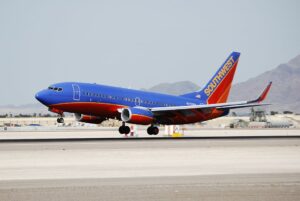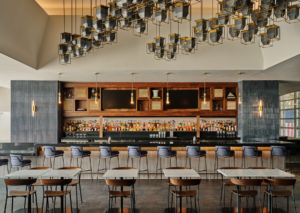Another blast from the past - Across the Pacific on a Freighter
#1
Moderator, OneWorld
Original Poster
Join Date: Feb 2002
Location: SEA
Programs: RAA RIP; AA ExEXP
Posts: 11,892
Another blast from the past - Across the Pacific on a Freighter
With lots of time on my hands (like most people on FT) I've decided to resurrect a trip report (which I've never posted here I think) from over 20 years ago. It involves a trans-Pacific crossing on a wide-body craft featuring flat beds, traveling at Mach 0.03. Yes, a ship.
Obligatory FT information. We flew from LAX to Nadi (NAN) on an Air New Zealand 767, in economy, from Nadi to Taveuni (TVU) and back on a Sunflower (now Fiji Link) Twin Otter, and from Nadi to Auckland on an Air Pacific (aka "Air Pathetic," now Fiji Airways) 767, also in economy. I don't remember much about the flights except that the NAN-AKL segment was exceptionally rough - I think we flew through a major blow of some kind.
The photos are scanned from prints, so apologies for the grain and some color fading.
- - - -
Across the Pacific on a Freighter
In 1998 my wife and I took sabbaticals from our jobs and spent four months traveling to various parts of the world. We first went to Europe and visited Holland, Portugal, Spain and parts of France over two months, then traveled to Israel to visit some of my wife’s family members. We returned home briefly, then flew to Fiji for a few days, then on to New Zealand for two weeks, during which we drove around the beautiful North Island.
To conclude the trip we boarded a freighter in Auckland which would take us to Los Angeles via Fiji.
Freighter cruises are a little-known method of travel. Several shipping lines offer passage to paying customers who travel for all or part of the freighter’s route, including, in some cases, all the way around the world. Fares are surprisingly affordable, typically US$100 - $120 per day per person. Accommodations are quite spacious compared to those on cruise ships, but of course amenities are much more limited. Passengers usually dine with the ship’s officers and have considerable freedom to move about the vessel, but because the ships travel long distances at relatively slow speeds, a great deal of self-reliance is required to avoid boredom. Off-ship communications are very limited; there’s little if any telecommunications or internet connectivity available, so one must come prepared with plenty of reading materials or other distractions.
We booked our cruise through a New Zealand-based freighter cruise agent, who we met a couple of days before sailing. There are several such travel agencies in business, in New Zealand, the UK and USA, and probably more in Europe and Asia than we were aware of.
The voyage
Our ship, the M/V Columbus California, was a day late in arriving in Auckland. Cargo ships’ schedules tend to be flexible, given such factors as weather at sea, delays in cargo handling in various ports, and so on. We chose a hotel room in Auckland with a good view of the harbor and remained in phone contact with the shipping line’s local agent. Thus we had a good view of our ship as it entered Auckland Harbour and maneuvered into position at its assigned terminal.
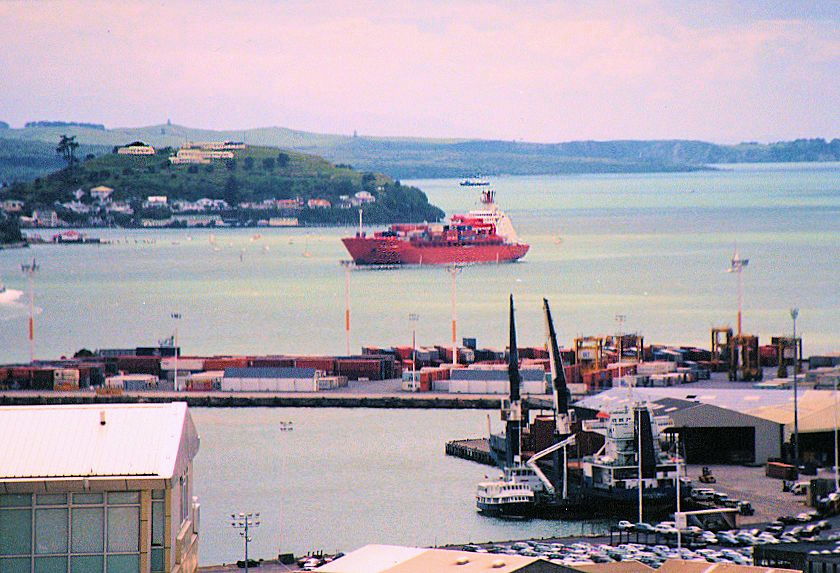

The Columbus California is relatively small as freighters go, around 30,000 deadweight tons, compared to the monster vessels that carry thousands of containers between major ports around the world. Our ship’s size, and its ability to load and unload cargo containers using its own on-board crane, made it suitable for serving less developed and smaller ports, such as Suva, Fiji, where we’d be stopping en route to California.
Once the agent phoned us and told us the ship had cleared NZ customs and was ready for boarding, we took a taxi to the dock terminal and were driven to the ship in a port authority van. We boarded via a very long and narrow stairway; fortunately a crew member assisted us with our luggage. We were shown to our cabin and were told that we would be the only passengers on this voyage. The ship has room for up to 8 passengers, but as we were traveling during the Christmas holiday period, there evidently was little demand for passage on this sailing.
Our cabin was spacious and very clean, comprising a sitting room with a single bed, wardrobe closet, desk, mini-fridge sofa and coffee table, and a couple of chairs, and a separate bedroom, also with a single bed and wardrobe. A small bathroom with sink, toilet and shower opened off the main sitting room.

The Columbus California was built in the 1970s, and the ship’s décor reflected it. It was well-maintained but definitely in need of refurbishment.
Two or three other cabins were located on the same deck, although we were the only passengers. Aft of our cabin was a solarium with a table tennis table and exercise bike, behind which was a deck looking out over the stern of the ship.
On the deck above ours was the dining room where we would take our meals, along with a large lounge for use by the passengers. The lounge contained several tables and chairs, a TV with a videotape player, a multi-band radio, and a modest library. Videotapes for viewing were kept in a small video library on the bridge, a deck above the lounge.
At the time the Columbus California was owned and operated by the Hamburg-Sűd company, a very large German shipping concern. We learned that the ship’s Captain and Chief Engineer, and one or two other officers, were German, while the First Officer was Polish. The ship’s crew comprised seven or eight officers, all from central or eastern Europe, and around 20 other crew members, most from the Pacific island nation of Kiribati, where Hamburg-Sűd evidently operates a maritime training academy.
We were assigned a steward (whose name I can't recall) who also served as the chief server in the officers’ mess.
On the evening of our scheduled departure (December 4, 1998) we sat for dinner in the officer’s dining room where we were surprised to meet the Captain’s wife, who was traveling with her husband on this voyage, as she sometimes did. She was English by birth and rearing, but had lived so long in Germany that her English had started to suffer; she would be speaking about the Queen but then lapse into German for a few words or a sentence.
We also met the ship’s first officer, Marek, a very engaging Pole, and the chief engineer, a very friendly tall German man, who suffered from a moderate hearing loss which, we would learn graphically, is what comes from working in the enormous engine rooms on big freighters.
We also learned that because of the ship’s late arrival into Auckland our sailing would be delayed until the next day, so our first night in our cabin was spent on a motionless ship, but not an especially quiet one, as the trucks and cranes continued to load containers all through the night. But around 2 PM the next afternoon the lines were drawn in and, assisted by a single tug, we sailed out of Auckland Harbour, made several turns, and presently we were on the Pacific Ocean, en route to Fiji. We were told we’d be at sea five days before reaching Suva.
Despite the season (late spring in New Zealand) the weather was cool and cloudy as the Auckland harbor pilot disembarked to his pilot ship, which had followed us closely as we sailed from the city.
We could see other ships at a distance as we left Auckland, but would see no other ships at sea for the entire journey across the Pacific, until we were less than two hours from arriving in California. I thought this was curious, but was told later that it’s the norm. It’s a very, very big ocean.
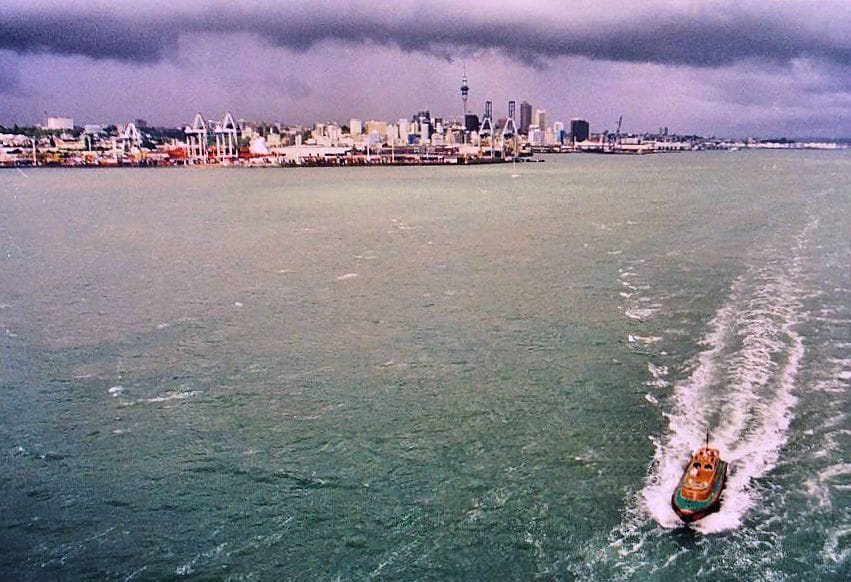
Obligatory FT information. We flew from LAX to Nadi (NAN) on an Air New Zealand 767, in economy, from Nadi to Taveuni (TVU) and back on a Sunflower (now Fiji Link) Twin Otter, and from Nadi to Auckland on an Air Pacific (aka "Air Pathetic," now Fiji Airways) 767, also in economy. I don't remember much about the flights except that the NAN-AKL segment was exceptionally rough - I think we flew through a major blow of some kind.
The photos are scanned from prints, so apologies for the grain and some color fading.
- - - -
Across the Pacific on a Freighter
In 1998 my wife and I took sabbaticals from our jobs and spent four months traveling to various parts of the world. We first went to Europe and visited Holland, Portugal, Spain and parts of France over two months, then traveled to Israel to visit some of my wife’s family members. We returned home briefly, then flew to Fiji for a few days, then on to New Zealand for two weeks, during which we drove around the beautiful North Island.
To conclude the trip we boarded a freighter in Auckland which would take us to Los Angeles via Fiji.
Freighter cruises are a little-known method of travel. Several shipping lines offer passage to paying customers who travel for all or part of the freighter’s route, including, in some cases, all the way around the world. Fares are surprisingly affordable, typically US$100 - $120 per day per person. Accommodations are quite spacious compared to those on cruise ships, but of course amenities are much more limited. Passengers usually dine with the ship’s officers and have considerable freedom to move about the vessel, but because the ships travel long distances at relatively slow speeds, a great deal of self-reliance is required to avoid boredom. Off-ship communications are very limited; there’s little if any telecommunications or internet connectivity available, so one must come prepared with plenty of reading materials or other distractions.
We booked our cruise through a New Zealand-based freighter cruise agent, who we met a couple of days before sailing. There are several such travel agencies in business, in New Zealand, the UK and USA, and probably more in Europe and Asia than we were aware of.
The voyage
Our ship, the M/V Columbus California, was a day late in arriving in Auckland. Cargo ships’ schedules tend to be flexible, given such factors as weather at sea, delays in cargo handling in various ports, and so on. We chose a hotel room in Auckland with a good view of the harbor and remained in phone contact with the shipping line’s local agent. Thus we had a good view of our ship as it entered Auckland Harbour and maneuvered into position at its assigned terminal.


The Columbus California is relatively small as freighters go, around 30,000 deadweight tons, compared to the monster vessels that carry thousands of containers between major ports around the world. Our ship’s size, and its ability to load and unload cargo containers using its own on-board crane, made it suitable for serving less developed and smaller ports, such as Suva, Fiji, where we’d be stopping en route to California.
Once the agent phoned us and told us the ship had cleared NZ customs and was ready for boarding, we took a taxi to the dock terminal and were driven to the ship in a port authority van. We boarded via a very long and narrow stairway; fortunately a crew member assisted us with our luggage. We were shown to our cabin and were told that we would be the only passengers on this voyage. The ship has room for up to 8 passengers, but as we were traveling during the Christmas holiday period, there evidently was little demand for passage on this sailing.
Our cabin was spacious and very clean, comprising a sitting room with a single bed, wardrobe closet, desk, mini-fridge sofa and coffee table, and a couple of chairs, and a separate bedroom, also with a single bed and wardrobe. A small bathroom with sink, toilet and shower opened off the main sitting room.

The Columbus California was built in the 1970s, and the ship’s décor reflected it. It was well-maintained but definitely in need of refurbishment.
Two or three other cabins were located on the same deck, although we were the only passengers. Aft of our cabin was a solarium with a table tennis table and exercise bike, behind which was a deck looking out over the stern of the ship.
On the deck above ours was the dining room where we would take our meals, along with a large lounge for use by the passengers. The lounge contained several tables and chairs, a TV with a videotape player, a multi-band radio, and a modest library. Videotapes for viewing were kept in a small video library on the bridge, a deck above the lounge.
At the time the Columbus California was owned and operated by the Hamburg-Sűd company, a very large German shipping concern. We learned that the ship’s Captain and Chief Engineer, and one or two other officers, were German, while the First Officer was Polish. The ship’s crew comprised seven or eight officers, all from central or eastern Europe, and around 20 other crew members, most from the Pacific island nation of Kiribati, where Hamburg-Sűd evidently operates a maritime training academy.
We were assigned a steward (whose name I can't recall) who also served as the chief server in the officers’ mess.
On the evening of our scheduled departure (December 4, 1998) we sat for dinner in the officer’s dining room where we were surprised to meet the Captain’s wife, who was traveling with her husband on this voyage, as she sometimes did. She was English by birth and rearing, but had lived so long in Germany that her English had started to suffer; she would be speaking about the Queen but then lapse into German for a few words or a sentence.
We also met the ship’s first officer, Marek, a very engaging Pole, and the chief engineer, a very friendly tall German man, who suffered from a moderate hearing loss which, we would learn graphically, is what comes from working in the enormous engine rooms on big freighters.
We also learned that because of the ship’s late arrival into Auckland our sailing would be delayed until the next day, so our first night in our cabin was spent on a motionless ship, but not an especially quiet one, as the trucks and cranes continued to load containers all through the night. But around 2 PM the next afternoon the lines were drawn in and, assisted by a single tug, we sailed out of Auckland Harbour, made several turns, and presently we were on the Pacific Ocean, en route to Fiji. We were told we’d be at sea five days before reaching Suva.
Despite the season (late spring in New Zealand) the weather was cool and cloudy as the Auckland harbor pilot disembarked to his pilot ship, which had followed us closely as we sailed from the city.
We could see other ships at a distance as we left Auckland, but would see no other ships at sea for the entire journey across the Pacific, until we were less than two hours from arriving in California. I thought this was curious, but was told later that it’s the norm. It’s a very, very big ocean.

#2
Moderator, OneWorld
Original Poster
Join Date: Feb 2002
Location: SEA
Programs: RAA RIP; AA ExEXP
Posts: 11,892
Part 2
We saw little of the officers and crew for the rest of the first day and most of the next; they were catching up on their rest, having worked for most of the 48 hours or so that the ship had been in Auckland.
Nevertheless, we attended a required practice lifeboat muster and got a brief tour of the ship’s superstructure, including the bridge, where we were welcome at any time except during docking and departure proceedings. We were free to walk about the decks, but admonished to stay safely away from hazardous-looking items, machinery or places where we’d be too close to unprotected ledges. The sea was 50 feet below us, and moving past at around 20 knots; looking down at the bow wave was impressive and not just a little scary.
Finally on the second or third day things settled into a routine that would be maintained all the way to North America. We would rise and go up to the officers’ mess for breakfast, which consisted mainly of bread, cheese, meats and coffee. Our steward asked us one morning if we would like eggs for breakfast; I said yes and for the rest of the trip I was presented with scrambled eggs daily. The bread was all baked on board, a surprising pleasure. Lunch was generally a bit more brief as it occurred during watch change-over time, so the officers would pop in and pop out. Dinner was more like breakfast; rather formal and predictable.
Unlike cruise ships where food is a central draw and theme, on the Columbus California meals were less about the food and more about socializing. The menu was aimed at German and eastern European diets – heavy on meats and starches – but by no means bad, just a little bland and bulky.
But because the ship was largely self-navigating with computer-assisted autopilot direction, the officers used mealtime to socialize and kibbutz, especially when the captain wasn’t present. The captain was a rather stern and stiff fellow – not unfriendly, but perhaps because his wife (who kept to her room) was along, he tended to eat and run. The first officer and the chief engineer, however, were both very gregarious, and we quickly developed a nice friendship with them. As one would imagine, both had a never-ending series of hilarious or hair-raising stories they could tell, but we were able to hold our own on the reciprocation front – my wife talking about her work on an Israeli kibbutz and being kidnapped by bandits on a tour of the Sinai; me about crashing in small planes in Alaska and being arrested in Iran for taking pictures of a secret police building. Mealtimes were scheduled for an hour, three times a day, but typically we would spend two or more hours schmoozing with the officers.
First Officer and Chief Engineer
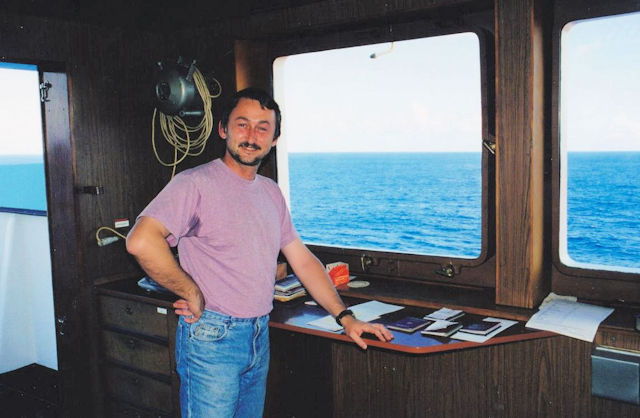
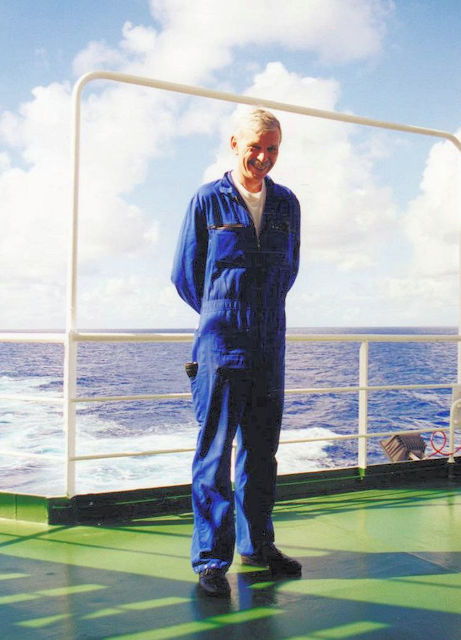
Bridge
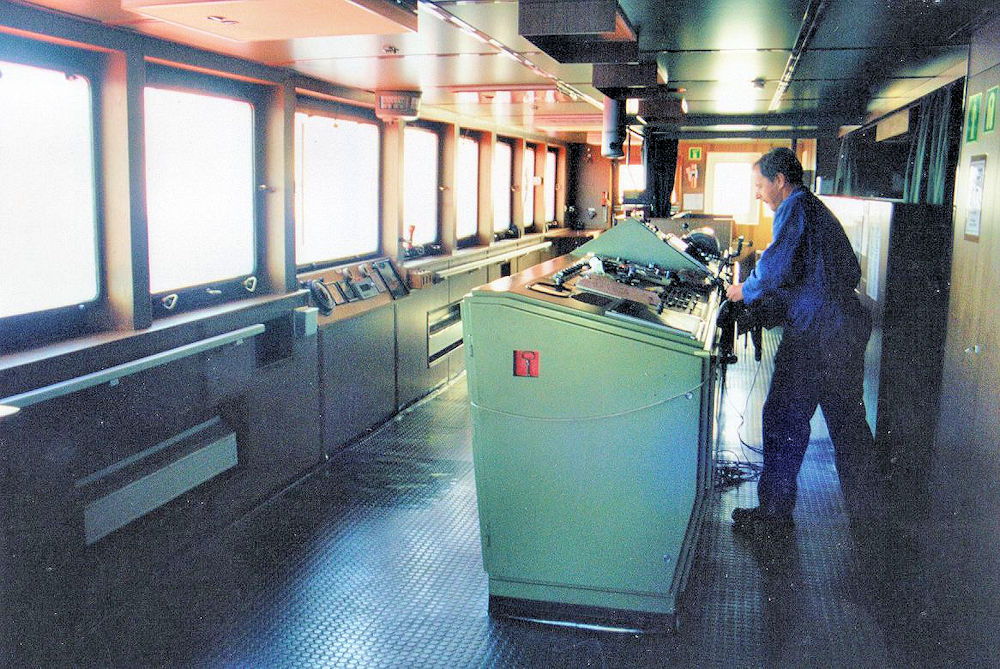
We were offered a tour of the engine room which we gratefully accepted. The scale, the heat and the noise were quite intimidating, almost scary; but the chief engineer was unabashedly in love with his ship, and could not refrain from singing her praises on any occasion.
On the morning of the fifth day after leaving Auckland, we arrived in Suva, the capital of the Republic of Fiji. My wife and I had just been in Fiji a couple of weeks prior, but we had spent our time on one of the smaller islands, Taveuni, and in the area around Nadi airport, on the other side of the island from Suva.
Suva isn’t an especially attractive city, but it’s very dynamic and busy. The Columbus California docked very close to Suva’s main bus station, and only a few hundred yards from the terrific public market that serves the capital and the surrounding communities. Suva is also the chief market town for a number of villages on small islands in the archipelago, so its harbor is full of constant motion as small watercraft come and go.


After the Fijian immigration and customs people had left the ship, we disembarked to explore our surroundings. We were told the ship would probably be here for 24 hours, so we were free to come and go in that time frame.
Our first mission going ashore was to search for a phone from which we could call relatives in Seattle to check in. But we also realized that we had exchanged all our Fijian money two weeks’ prior for New Zealand currency, so even before the phone we had to find a bank to cash some travelers checks or use the ATM.
This we accomplished with more difficulty than we anticipated; all of “downtown” Suva was crowded with people doing Christmas shopping. Seeing Santa Claus and Christmas lights beneath coconut palm trees was rather disconcerting.

The weather was stifling as we found a telephone booth on a side street, and while we were talking to our family it started to rain. And then it rained harder. And harder. And now it was a downpour of biblical scale. What to do? Heading back to the ship would only get us soaked, plus it was still hours before dinner time.
So of course we went to the movies. Right next to McDonald’s was a multi-screen theater featuring popcorn and Cokes. The air conditioning was cranked up to the max. Little kids were running up and down the aisle before the movie started, while slides advertising local businesses were projected onto the screen. Weird.
The rain had stopped by the time the movie was over, so we hurried to the ship and managed to get up the gangway just as the skies opened a second time.
At breakfast the next morning we were informed by a grumpy captain that we weren’t sailing today after all. Apparently there was a holdup on some cargo getting to the ship on time; radio messages had been exchanged, the local stevedores were “going slow,” blah blah. So with another day in Suva, this time in good weather, we hit the streets and headed for the market and adjacent crafts market.
When we got down to the pier, we discovered that during the night a cruise ship had moored right in front of us. It was a rather old Princess ship, looking like something from the Love Boat TV series, on a cruise out of Australia. The passengers had all disembarked by the time we got there (a couple still wandering around, obviously they’d passed on the pricey excursions laid on by the cruise line) but there was another crowd down at the end of the dock.
It turned out this group was gathered for prayers and blessings accompanying the first voyage of a new passenger ferry serving some of the outer islands. There were local dignitaries and preachers dressed in traditional Fijian sulus, and local dancers doing intricate moves while one of those amazing Polynesian choirs did their thing, switching from conventional hymns to Christmas carols. A pretty amazing sight. We watched this scene for a time, then wandered toward the market.
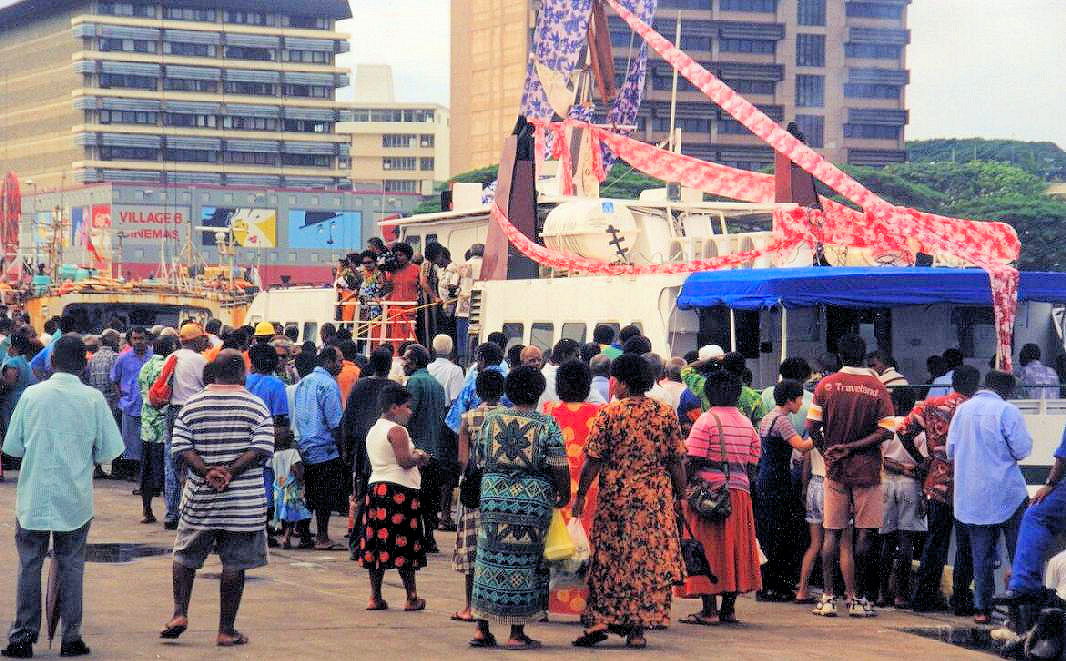

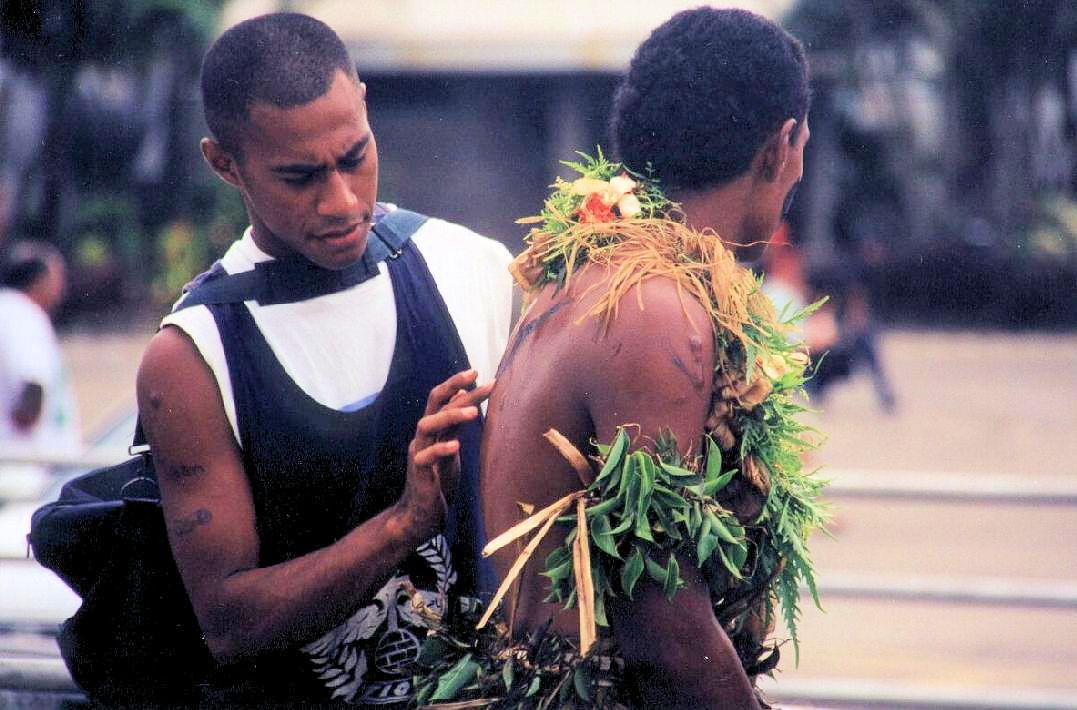
Suva’s public market is quite large, with a couple of indoor halls where items like meat and staples are sold from permanent stands, and a large outdoor area where farmers or merchants simply spread out their produce in an informal but well-organized plaza.
All sorts of produce is on sale – tubers and roots of various kinds, sugar cane stalks, taro, coconuts, and several kinds of pineapples including the devilishly sweet “mini” pineapples found throughout the South Pacific. We didn’t recognize half the fruits or vegetables, and wouldn’t know how (or be able) to prepare them, but the scene was magical.
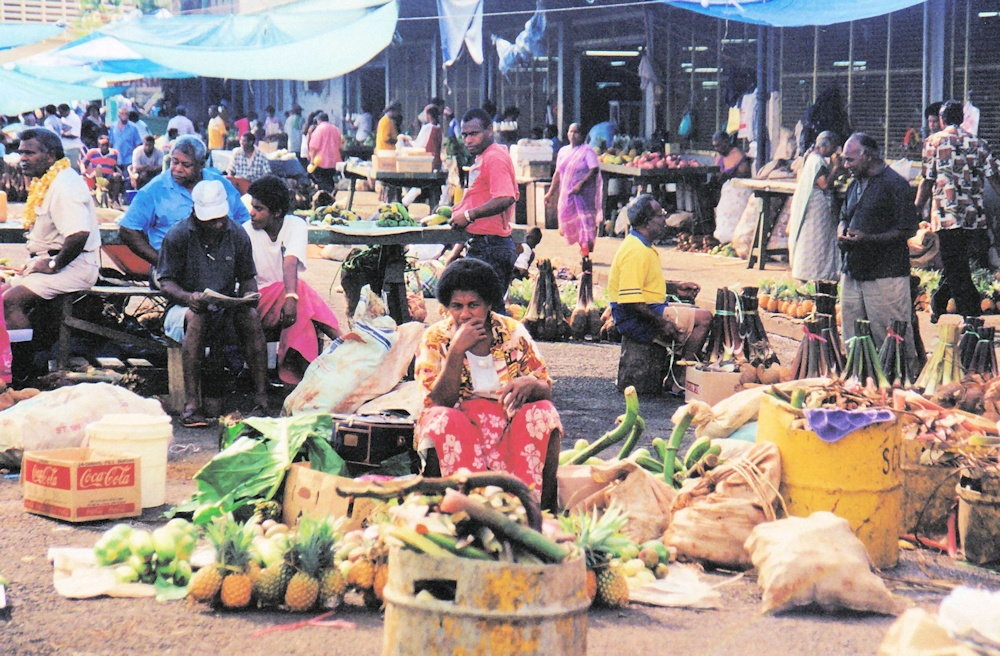
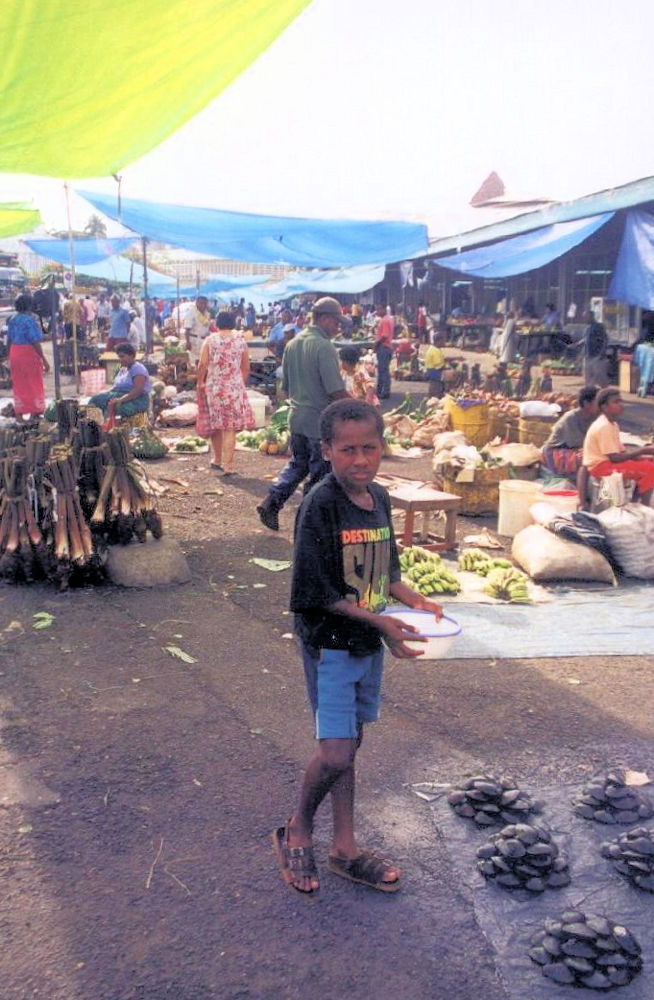
Inside one of the big halls a ramp led up to a mezzanine level in which dozens of kava sellers were manning counters heaped with the slightly narcotic root, made into a drink by Fijians and called “grog” on the islands. This was the busiest part of the whole market, with animated negotiations taking place all across the floor.
We wandered over to the fish market adjacent to the main area, where the action was much less visible. We agreed that we were probably too late in the day; like fish markets everywhere the freshest fish is often gone by mid-morning. There were a few brightly-colored fish here and there, but we didn’t tarry.

The crafts market was adjacent, and here too we figured we were too late, or maybe too early, for the main action, which would surely be focused on the many cruise ship passengers who already had been, or soon would be, patrons for the various items on sale, chief among them various clubs and pointed implements hearkening back to Fiji’s cannibal days. (“Cannibal forks” are a big seller, and my wife bought a couple to give as gifts to her colleagues in the banking business back in Seattle.) It was mostly the sort of tourist junk one would expect, so we were gone quickly.
We wandered around the fishing harbor for a while, looking at rusty Chinese fishing boats crewed by sullen-looking crews, the unmistakable sheen of fuel oil on the water around the hulls.

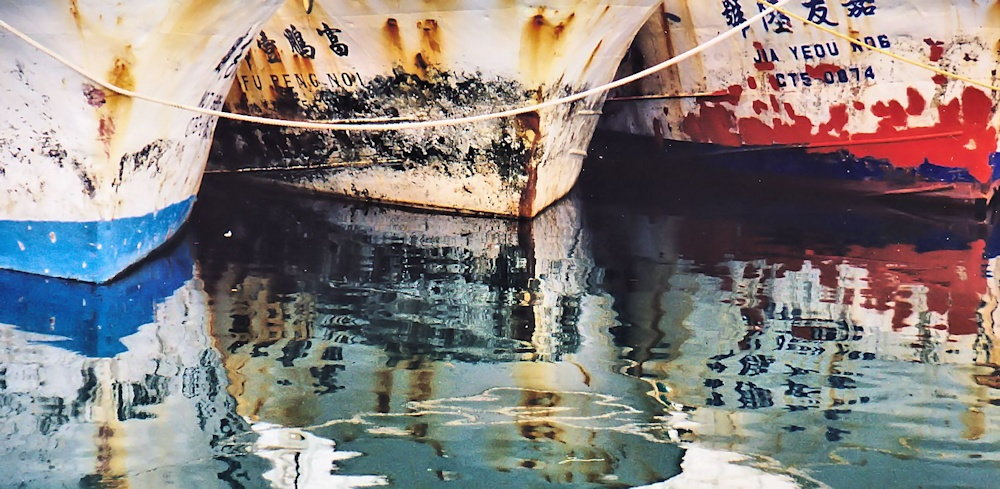
By this time the heat and humidity was getting to us, and it was threatening to rain again, so we retreated back to the air conditioning of our ship, stopping on the way for a couple of “six packs” of tiny, delicious pineapples, which we stored in our cabin’s little refrigerator and rationed to ourselves most of the way across the ocean.
Back on the ship, things were still rather chaotic on the freight-loading front, so it was not until early evening that the captain declared that enough was enough, summoned the pilot, booted off the remaining stevedores, and blew the ship’s horn. Bula, Fiji and bon voyage.
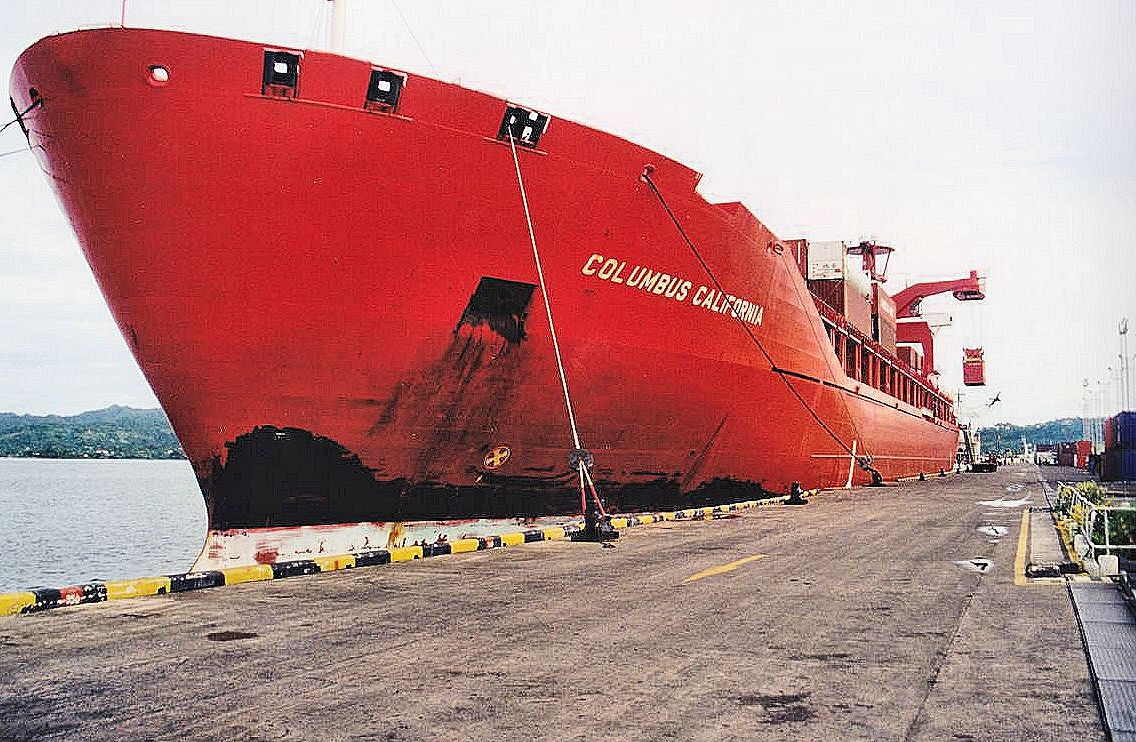

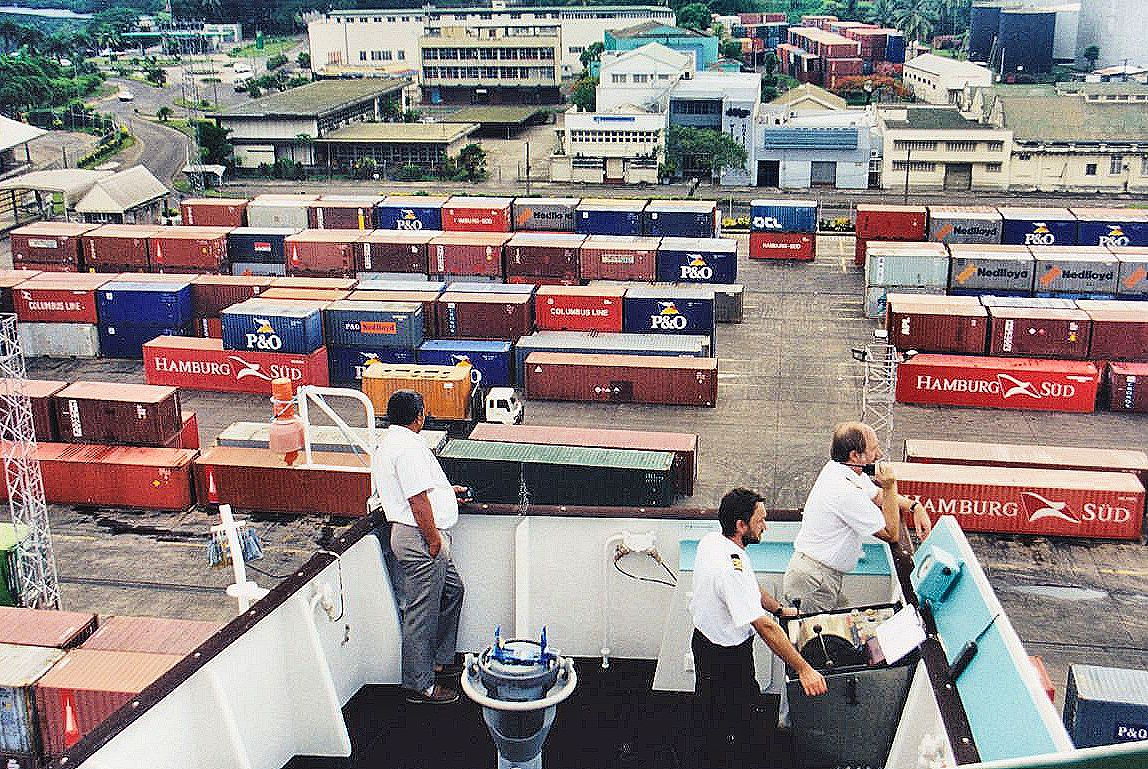
We saw little of the officers and crew for the rest of the first day and most of the next; they were catching up on their rest, having worked for most of the 48 hours or so that the ship had been in Auckland.
Nevertheless, we attended a required practice lifeboat muster and got a brief tour of the ship’s superstructure, including the bridge, where we were welcome at any time except during docking and departure proceedings. We were free to walk about the decks, but admonished to stay safely away from hazardous-looking items, machinery or places where we’d be too close to unprotected ledges. The sea was 50 feet below us, and moving past at around 20 knots; looking down at the bow wave was impressive and not just a little scary.
Finally on the second or third day things settled into a routine that would be maintained all the way to North America. We would rise and go up to the officers’ mess for breakfast, which consisted mainly of bread, cheese, meats and coffee. Our steward asked us one morning if we would like eggs for breakfast; I said yes and for the rest of the trip I was presented with scrambled eggs daily. The bread was all baked on board, a surprising pleasure. Lunch was generally a bit more brief as it occurred during watch change-over time, so the officers would pop in and pop out. Dinner was more like breakfast; rather formal and predictable.
Unlike cruise ships where food is a central draw and theme, on the Columbus California meals were less about the food and more about socializing. The menu was aimed at German and eastern European diets – heavy on meats and starches – but by no means bad, just a little bland and bulky.
But because the ship was largely self-navigating with computer-assisted autopilot direction, the officers used mealtime to socialize and kibbutz, especially when the captain wasn’t present. The captain was a rather stern and stiff fellow – not unfriendly, but perhaps because his wife (who kept to her room) was along, he tended to eat and run. The first officer and the chief engineer, however, were both very gregarious, and we quickly developed a nice friendship with them. As one would imagine, both had a never-ending series of hilarious or hair-raising stories they could tell, but we were able to hold our own on the reciprocation front – my wife talking about her work on an Israeli kibbutz and being kidnapped by bandits on a tour of the Sinai; me about crashing in small planes in Alaska and being arrested in Iran for taking pictures of a secret police building. Mealtimes were scheduled for an hour, three times a day, but typically we would spend two or more hours schmoozing with the officers.
First Officer and Chief Engineer


Bridge

We were offered a tour of the engine room which we gratefully accepted. The scale, the heat and the noise were quite intimidating, almost scary; but the chief engineer was unabashedly in love with his ship, and could not refrain from singing her praises on any occasion.
On the morning of the fifth day after leaving Auckland, we arrived in Suva, the capital of the Republic of Fiji. My wife and I had just been in Fiji a couple of weeks prior, but we had spent our time on one of the smaller islands, Taveuni, and in the area around Nadi airport, on the other side of the island from Suva.
Suva isn’t an especially attractive city, but it’s very dynamic and busy. The Columbus California docked very close to Suva’s main bus station, and only a few hundred yards from the terrific public market that serves the capital and the surrounding communities. Suva is also the chief market town for a number of villages on small islands in the archipelago, so its harbor is full of constant motion as small watercraft come and go.


After the Fijian immigration and customs people had left the ship, we disembarked to explore our surroundings. We were told the ship would probably be here for 24 hours, so we were free to come and go in that time frame.
Our first mission going ashore was to search for a phone from which we could call relatives in Seattle to check in. But we also realized that we had exchanged all our Fijian money two weeks’ prior for New Zealand currency, so even before the phone we had to find a bank to cash some travelers checks or use the ATM.
This we accomplished with more difficulty than we anticipated; all of “downtown” Suva was crowded with people doing Christmas shopping. Seeing Santa Claus and Christmas lights beneath coconut palm trees was rather disconcerting.

The weather was stifling as we found a telephone booth on a side street, and while we were talking to our family it started to rain. And then it rained harder. And harder. And now it was a downpour of biblical scale. What to do? Heading back to the ship would only get us soaked, plus it was still hours before dinner time.
So of course we went to the movies. Right next to McDonald’s was a multi-screen theater featuring popcorn and Cokes. The air conditioning was cranked up to the max. Little kids were running up and down the aisle before the movie started, while slides advertising local businesses were projected onto the screen. Weird.
The rain had stopped by the time the movie was over, so we hurried to the ship and managed to get up the gangway just as the skies opened a second time.
At breakfast the next morning we were informed by a grumpy captain that we weren’t sailing today after all. Apparently there was a holdup on some cargo getting to the ship on time; radio messages had been exchanged, the local stevedores were “going slow,” blah blah. So with another day in Suva, this time in good weather, we hit the streets and headed for the market and adjacent crafts market.
When we got down to the pier, we discovered that during the night a cruise ship had moored right in front of us. It was a rather old Princess ship, looking like something from the Love Boat TV series, on a cruise out of Australia. The passengers had all disembarked by the time we got there (a couple still wandering around, obviously they’d passed on the pricey excursions laid on by the cruise line) but there was another crowd down at the end of the dock.
It turned out this group was gathered for prayers and blessings accompanying the first voyage of a new passenger ferry serving some of the outer islands. There were local dignitaries and preachers dressed in traditional Fijian sulus, and local dancers doing intricate moves while one of those amazing Polynesian choirs did their thing, switching from conventional hymns to Christmas carols. A pretty amazing sight. We watched this scene for a time, then wandered toward the market.



Suva’s public market is quite large, with a couple of indoor halls where items like meat and staples are sold from permanent stands, and a large outdoor area where farmers or merchants simply spread out their produce in an informal but well-organized plaza.
All sorts of produce is on sale – tubers and roots of various kinds, sugar cane stalks, taro, coconuts, and several kinds of pineapples including the devilishly sweet “mini” pineapples found throughout the South Pacific. We didn’t recognize half the fruits or vegetables, and wouldn’t know how (or be able) to prepare them, but the scene was magical.


Inside one of the big halls a ramp led up to a mezzanine level in which dozens of kava sellers were manning counters heaped with the slightly narcotic root, made into a drink by Fijians and called “grog” on the islands. This was the busiest part of the whole market, with animated negotiations taking place all across the floor.
We wandered over to the fish market adjacent to the main area, where the action was much less visible. We agreed that we were probably too late in the day; like fish markets everywhere the freshest fish is often gone by mid-morning. There were a few brightly-colored fish here and there, but we didn’t tarry.

The crafts market was adjacent, and here too we figured we were too late, or maybe too early, for the main action, which would surely be focused on the many cruise ship passengers who already had been, or soon would be, patrons for the various items on sale, chief among them various clubs and pointed implements hearkening back to Fiji’s cannibal days. (“Cannibal forks” are a big seller, and my wife bought a couple to give as gifts to her colleagues in the banking business back in Seattle.) It was mostly the sort of tourist junk one would expect, so we were gone quickly.
We wandered around the fishing harbor for a while, looking at rusty Chinese fishing boats crewed by sullen-looking crews, the unmistakable sheen of fuel oil on the water around the hulls.


By this time the heat and humidity was getting to us, and it was threatening to rain again, so we retreated back to the air conditioning of our ship, stopping on the way for a couple of “six packs” of tiny, delicious pineapples, which we stored in our cabin’s little refrigerator and rationed to ourselves most of the way across the ocean.
Back on the ship, things were still rather chaotic on the freight-loading front, so it was not until early evening that the captain declared that enough was enough, summoned the pilot, booted off the remaining stevedores, and blew the ship’s horn. Bula, Fiji and bon voyage.



#3
Moderator, OneWorld
Original Poster
Join Date: Feb 2002
Location: SEA
Programs: RAA RIP; AA ExEXP
Posts: 11,892
Part 3
We sailed from Suva, past a rusting shipwreck left as a reminder of the perils of the reefs that bracket the harbor entrances, and turned north by east toward California. Our sailing time to Los Angeles was to be thirteen days, but one day out of Fiji, Marek, the first officer, told us at breakfast that orders had come from headquarters that we were to go to San Francisco before LA, and since they didn’t know how long they’d be in San Francisco, we’d be put ashore there instead of San Pedro. Fair enough, we’d been warned that changes to itineraries were a fact of life with freighters, so we just relaxed and figured we’d work things out once we got there.
The remainder of the trip was, in a sense, time lost from the record. We would rise, have breakfast and chat with the officers, read books, put together enormously complicated jigsaw puzzles available in the passenger lounge. I would walk around the deck, go up to the bridge and look at navigation charts or talk about the shipping business. Some days the seas would be a little rough, and while the ship was quite stable, since the bulk of her containers were stowed at or below the water line, along with the huge tanks of bunker fuel and seawater ballast used to compensate for consumed fuel’s weight, we did get days when the pitch and roll of the ship lead to queasy tummies. Neither of us actually got sick, however. Mainly we just hung out, a very unusual thing for us.
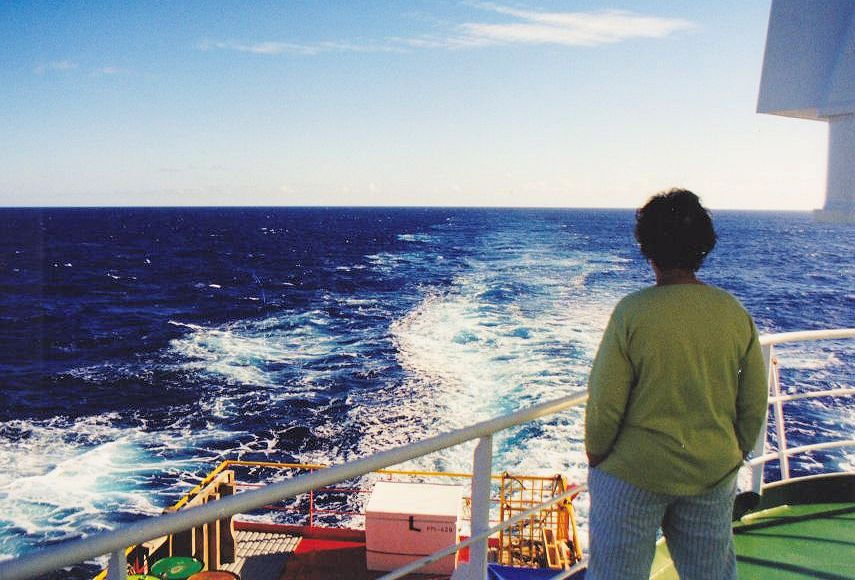


A couple of days out of Suva we crossed the equator (the date line bisects Fiji but jogs around it for convenience) and as it was also my wife’s birthday, the customary barbecue held toward the end of the trip was advanced, and the cook baked an actual birthday cake for her. There was even beer. Burgers, steaks, beer and chocolate cake in the middle of the Pacific, Latitude 0. (We ate the cake inside as the ship was starting to roll a bit. Or maybe it was the beer.)

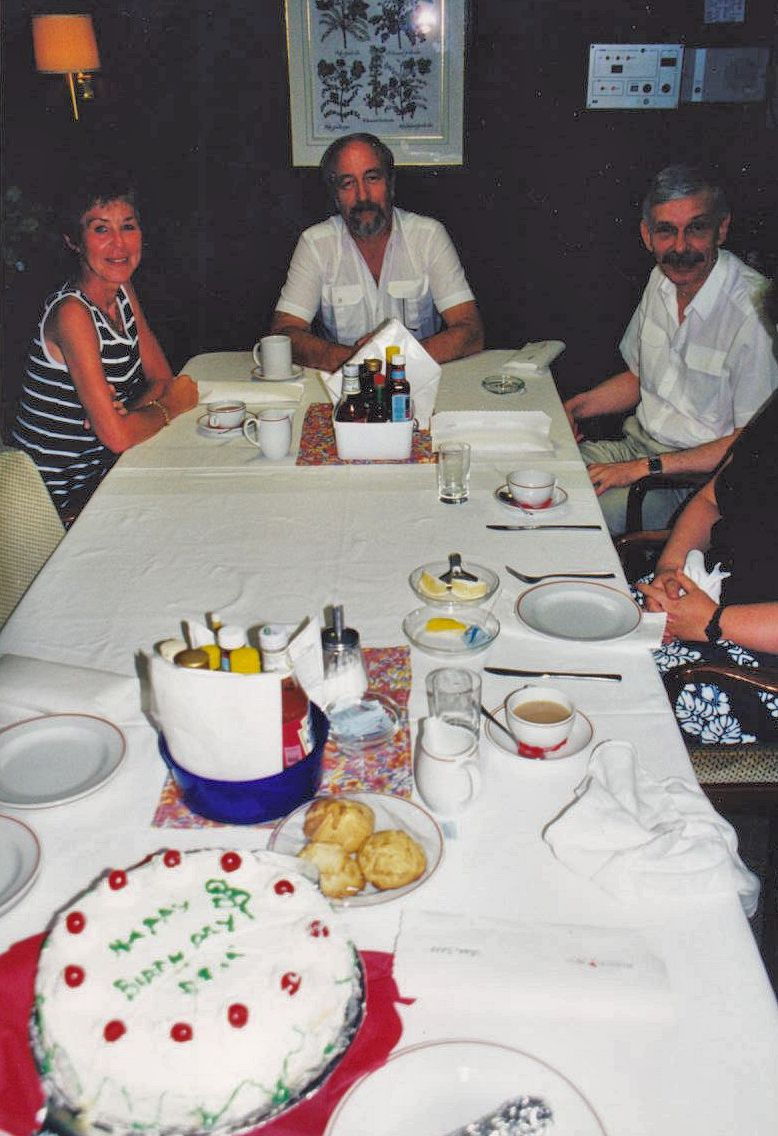
By this time we’d pretty well run through all the English-language videos available in the ship’s library, and didn’t particularly want to watch any of the German-language porn tapes that the first officer told us about, clearly contemptuous of some of “them.” (Still not much love lost between the Polish and the Germans, he explained.)
But sex was still a topic of conversation as my wife and I were glued to the short wave radio in the passengers’ lounge as the saga of President Clinton’s impeachment played out, courtesy of the Australian Broadcasting Company’s overseas service. The ship’s officers were bewildered at the whole thing. Weren’t we all?
But the days came and went and the ocean continued to hiss beneath the bow. We saw some flying fish, but no birds this far from land, not even an albatross. And no ships. Nothing but vast ocean in all directions.
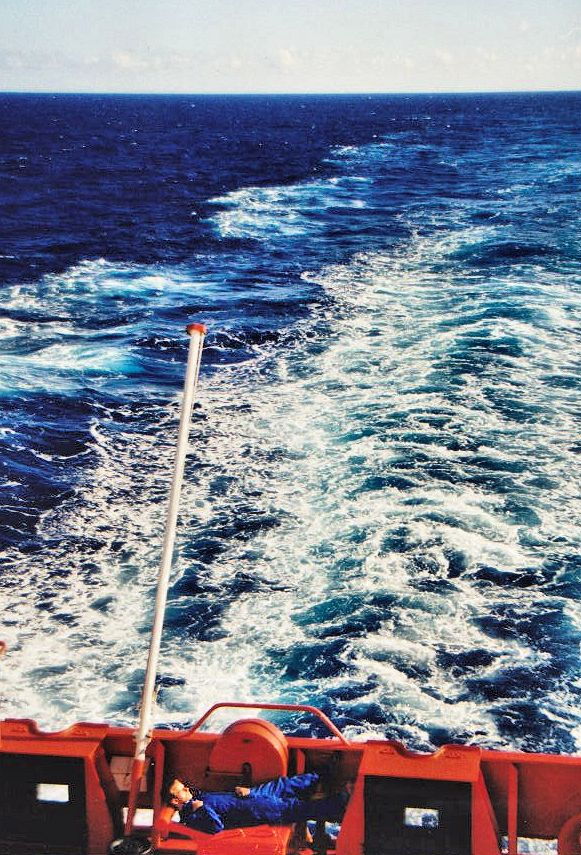
A few days after the barbecue we were both on the bridge with Marek. I was standing next to the ship’s wheel, the size of a steering wheel in a Toyota, when Marek asked if I’d like to steer the boat. Hell, yes, I would.
So he switched off the autopilot (which caused a buzzer to sound momentarily) and told me to take the wheel and keep it pointed on the present compass heading. I “tested” the wheel and was stunned how responsive the ship was; a slight turn on the wheel immediately resulted in the compass showing a new heading. It was like driving a very, very big sports car.
Then he gave the wheel to my wife, who fixed her eyes on the horizon instead of the digital compass, and after a minute Marek took the wheel and switched the autopilot back on. He said she had the boat pointing toward Mexico, which wouldn’t sit well with the corporate bigwigs in Germany.
The weather grew colder day by day, and on Christmas Eve a crew member raised the American flag on the line used for the flags of the country whose territorial waters are under the keel.

We stood on the deck, the cold wind buffeting us, as the sun set and the San Francisco pilot approached near the Farallons. We saw other ships for the first time in two weeks, in this case big container boats sailing toward Asia.
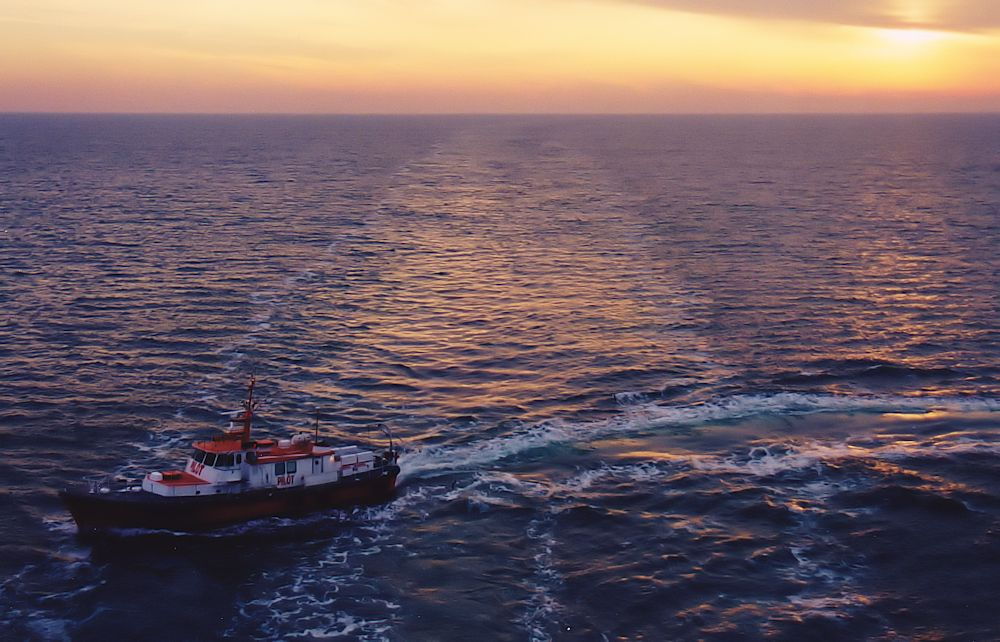
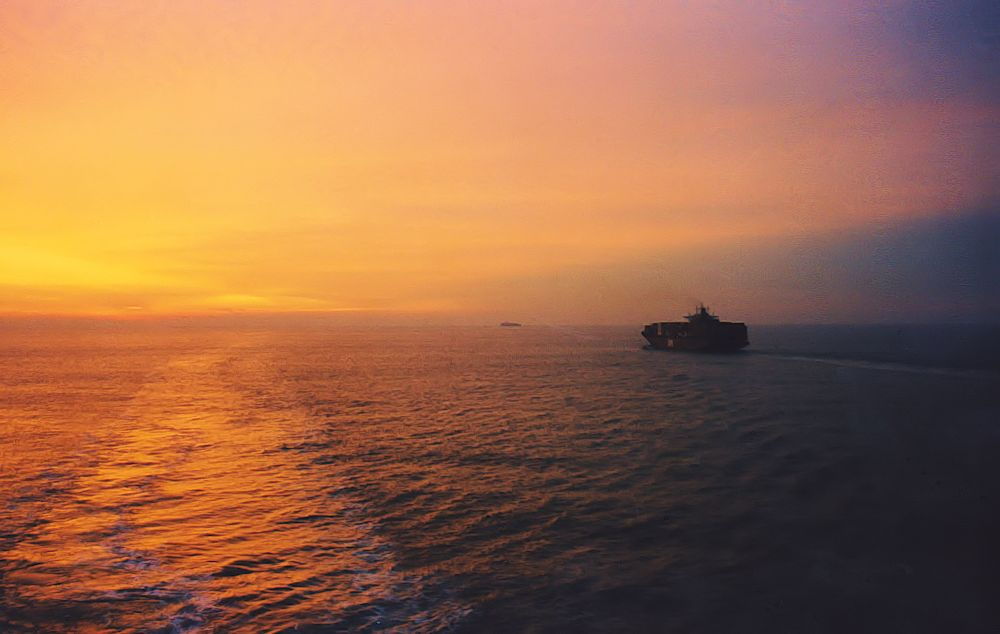
At last light we sailed under the Golden Gate Bridge, and using a single tug and the ship’s thrusters, parked at a pier. The US immigration and customs people were slow in arriving, but it didn’t matter; a Christmas tree had miraculously materialized in the officers’ mess, and a very German Christmas dinner of venison and potatoes was served, along with something that I thought was gluhwein. Yuck, but we weren’t disembarking until the morning anyway.
Christmas was cold and clear in San Francisco. There were hugs and addresses exchanged, then I walked to the guard post at the terminal’s gate to have a taxi called; presently it arrived and took us to the airport. We had to fly to LAX to meet our son, who lived in the area. He had been expecting us to arrive in San Pedro the previous day. But the flights were full so we decided to drive. At the Hertz counter I discovered my drivers license was still in the safekeeping of the rental car place in Auckland, so my wife got the honors. She was not happy about this.
We sailed from Suva, past a rusting shipwreck left as a reminder of the perils of the reefs that bracket the harbor entrances, and turned north by east toward California. Our sailing time to Los Angeles was to be thirteen days, but one day out of Fiji, Marek, the first officer, told us at breakfast that orders had come from headquarters that we were to go to San Francisco before LA, and since they didn’t know how long they’d be in San Francisco, we’d be put ashore there instead of San Pedro. Fair enough, we’d been warned that changes to itineraries were a fact of life with freighters, so we just relaxed and figured we’d work things out once we got there.
The remainder of the trip was, in a sense, time lost from the record. We would rise, have breakfast and chat with the officers, read books, put together enormously complicated jigsaw puzzles available in the passenger lounge. I would walk around the deck, go up to the bridge and look at navigation charts or talk about the shipping business. Some days the seas would be a little rough, and while the ship was quite stable, since the bulk of her containers were stowed at or below the water line, along with the huge tanks of bunker fuel and seawater ballast used to compensate for consumed fuel’s weight, we did get days when the pitch and roll of the ship lead to queasy tummies. Neither of us actually got sick, however. Mainly we just hung out, a very unusual thing for us.



A couple of days out of Suva we crossed the equator (the date line bisects Fiji but jogs around it for convenience) and as it was also my wife’s birthday, the customary barbecue held toward the end of the trip was advanced, and the cook baked an actual birthday cake for her. There was even beer. Burgers, steaks, beer and chocolate cake in the middle of the Pacific, Latitude 0. (We ate the cake inside as the ship was starting to roll a bit. Or maybe it was the beer.)


By this time we’d pretty well run through all the English-language videos available in the ship’s library, and didn’t particularly want to watch any of the German-language porn tapes that the first officer told us about, clearly contemptuous of some of “them.” (Still not much love lost between the Polish and the Germans, he explained.)
But sex was still a topic of conversation as my wife and I were glued to the short wave radio in the passengers’ lounge as the saga of President Clinton’s impeachment played out, courtesy of the Australian Broadcasting Company’s overseas service. The ship’s officers were bewildered at the whole thing. Weren’t we all?
But the days came and went and the ocean continued to hiss beneath the bow. We saw some flying fish, but no birds this far from land, not even an albatross. And no ships. Nothing but vast ocean in all directions.

A few days after the barbecue we were both on the bridge with Marek. I was standing next to the ship’s wheel, the size of a steering wheel in a Toyota, when Marek asked if I’d like to steer the boat. Hell, yes, I would.
So he switched off the autopilot (which caused a buzzer to sound momentarily) and told me to take the wheel and keep it pointed on the present compass heading. I “tested” the wheel and was stunned how responsive the ship was; a slight turn on the wheel immediately resulted in the compass showing a new heading. It was like driving a very, very big sports car.
Then he gave the wheel to my wife, who fixed her eyes on the horizon instead of the digital compass, and after a minute Marek took the wheel and switched the autopilot back on. He said she had the boat pointing toward Mexico, which wouldn’t sit well with the corporate bigwigs in Germany.
The weather grew colder day by day, and on Christmas Eve a crew member raised the American flag on the line used for the flags of the country whose territorial waters are under the keel.

We stood on the deck, the cold wind buffeting us, as the sun set and the San Francisco pilot approached near the Farallons. We saw other ships for the first time in two weeks, in this case big container boats sailing toward Asia.


At last light we sailed under the Golden Gate Bridge, and using a single tug and the ship’s thrusters, parked at a pier. The US immigration and customs people were slow in arriving, but it didn’t matter; a Christmas tree had miraculously materialized in the officers’ mess, and a very German Christmas dinner of venison and potatoes was served, along with something that I thought was gluhwein. Yuck, but we weren’t disembarking until the morning anyway.
Christmas was cold and clear in San Francisco. There were hugs and addresses exchanged, then I walked to the guard post at the terminal’s gate to have a taxi called; presently it arrived and took us to the airport. We had to fly to LAX to meet our son, who lived in the area. He had been expecting us to arrive in San Pedro the previous day. But the flights were full so we decided to drive. At the Hertz counter I discovered my drivers license was still in the safekeeping of the rental car place in Auckland, so my wife got the honors. She was not happy about this.
#6
FlyerTalk Evangelist
Join Date: Apr 2001
Location: East Ester, Alaska
Programs: Alaska Million Miler, United Million Miler, Wyndham Rewards Diamond, Choice Hotels Diamond
Posts: 12,171
What a gem from one of my favorite reporters on FT! I've hardly been over to the trip report forum over the past six months, and reports like this serve as incentive to once again spend a bit more time over here. Thanks again, Gardyloo 

#9
Join Date: Mar 2005
Location: Dallas, TX
Programs: AA Concierge Key, SPG Plat, Hyatt Diam
Posts: 528
This is such a nice trip report. My boss at my first job out of college moved to the US from South Africa on a freighter. This was in 1978 and still talks about the experience.
#13
Join Date: Oct 2009
Location: Boston, USA
Programs: AA EXP, TK Elite, HH Gold, SPG/Marriott Gold
Posts: 939
Cool report. Thanks for sharing ! Is it still possible to ride in merchant marine ships ? Are there any agents
that are specialized in this ? Thanks in advance...
that are specialized in this ? Thanks in advance...
#14
Moderator, OneWorld
Original Poster
Join Date: Feb 2002
Location: SEA
Programs: RAA RIP; AA ExEXP
Posts: 11,892


